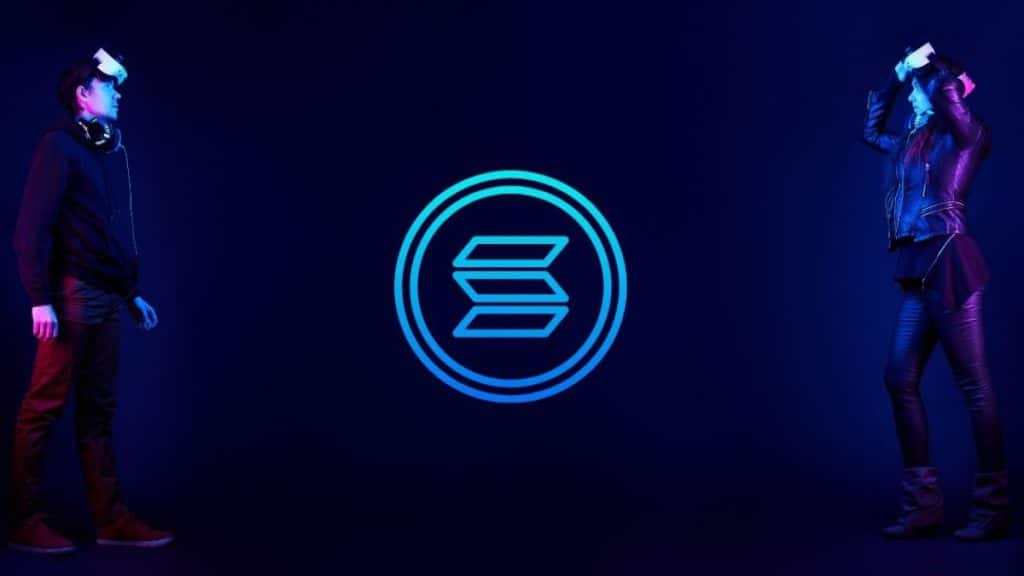The shared virtual world where people can work, play, and connect is known by another name: metaverse. Building this digital universe while keeping it decentralized requires technology that can handle millions of users and transactions at once. Traditional web systems, as robust as they are, struggle with this task, especially when users want to truly own their digital items.
We will make a case for how Solana, a fast blockchain, might become the foundation for tomorrow’s metaverse. Let’s look at its technical strengths, how it’s being used, and how to join this growing ecosystem.
The Technical Foundations — Speed and Scalability
Proof of History (PoH) and High Transaction Throughput
For consensus and therefore, security, Solana uses a special system called Proof of History (PoH) that works differently from other blockchains. Instead of nodes needing to agree on time, Solana creates a record that proves when events happen.
No lag allows Solana to process up to 65,000 transactions per second. For metaverse worlds where thousands of users trade items or buy land simultaneously, this speed is not just a feature but a must.
Low Transaction Fees: Enabling Mass Adoption
For the metaverse to grow, transactions must be cheap. Solana shines here with fees under $0.01 per transaction.
Think about a virtual concert where fans buy digital items or tip performers. If each action cost several dollars (as on some blockchains), few would participate. Solana’s low fees make these small transactions practical.
Scalability for Immersive Experiences
As virtual worlds grow more complex, they need more computing power to become a bit less virtual to us. Solana can add more nodes to increase capacity rather than requiring more powerful individual computers.
This approach works well for the growing demands of metaverse apps. As virtual worlds become more detailed and user numbers grow, Solana can scale up to meet these needs.
Solana’s Role in Metaverse Development
NFTs and Digital Ownership
True ownership of digital assets—avatars, virtual land, and in-game items—is a key trait of a decentralized metaverse. Solana’s NFT system provides the tools for this ownership model.
Solana NFTs offer:
- Fast creation and trading with tiny fees
- Smart NFTs that can change based on how they’re used
- Support for complex 3D assets
Markets like Magic Eden and Solanart have already handled billions in NFT trades on Solana, showing the network can support major metaverse activity.
Decentralized Gaming and Virtual Worlds
Gaming is a natural entry point for metaverse adoption. Solana’s speed makes it ideal for games that need frequent updates and in-game transactions.
Several Solana games are building metaverse elements:
- Star Atlas: A space strategy game with its own economy
- Aurory: An adventure game with collectible characters
- DeFi Land: A farm simulation mixing finance and gaming
These projects show how Solana can support complex games that would be too slow or costly on other blockchains.
Social Interactions and Virtual Events
The metaverse will transform how we socialize online. Solana’s fast network can support real-time interaction during virtual gatherings.
For example, at a Solana-based virtual concert, thousands could:
- Buy limited edition virtual items instantly
- Interact with performers through tips or votes
- Receive attendance proof NFTs in real time
Solana’s speed makes these synchronized experiences possible without lag or high costs.
Decentralized Commerce and Marketplaces
Virtual economies are central to the metaverse. Solana is well-suited to power shopping and trading within these worlds.
Markets built on Solana have proven they can handle high-volume trading. For the metaverse, this means robust systems for:
- In-world shops
- User-to-user trading
- Auction houses for rare items
- Rental markets for virtual land
Low fees and fast settlement make Solana attractive for metaverse commerce.
Participating in the Solana Metaverse
Why Buy SOL Crypto for Metaverse Interactions?
SOL serves many purposes in the Solana metaverse:
- It pays for transaction fees
- Many projects require SOL for purchases
- It’s needed for voting in Solana-based organizations
- It’s often used for creating NFTs or buying virtual land
To join Solana metaverse projects, you’ll likely need some SOL.
Where to Buy SOL Crypto?
You can do it on most major crypto exchanges:
- Centralized exchanges (Binance, Coinbase, Kraken)
- Decentralized exchanges (Raydium, Serum)
- Payment apps: Some apps like PayPal now support SOL
When choosing a place to buy SOL crypto, consider:
- The exchange’s security history
- Available payment methods
- Fees
- Availability in your country
New users might prefer centralized exchanges for simplicity, while seasoned crypto users often choose decentralized options.
Keeping Bought SOL Safe and Sound
Keep these security tips in mind:
- Consider hardware wallets like Ledger for long-term storage
- Software wallets like Phantom work well for active use
- Enable two-factor authentication on exchange accounts
- Watch out for fake websites and verify all URLs
Remember that crypto transactions can’t be reversed, so security is vital.
Real-World Projects and Use Cases
Solana-Based Metaverse Projects and Games
Several projects are already building metaverse experiences on Solana:
Star Atlas is an ambitious space game with its own economy, territory control, and spaceship combat. It has already made millions through NFT sales.
Portals focuses on virtual real estate where users can buy, customize, and profit from virtual spaces.
Aurory combines gaming with collectible characters in a story-driven world.
These projects show different aspects of the metaverse, all built on Solana.
Success Stories and Early Adopters
Early users of Solana’s metaverse are seeing benefits: Artists on platforms like Audius are finding new ways to earn money. Virtual land investors have seen their holdings grow in value.
Game developers can create more responsive experiences than on other blockchains. These successes suggest Solana’s technical strengths translate to real benefits for users.
The Impact on Creators and Developers
Solana’s developer tools continue to grow:
- Metaplex provides standardized tools for creating NFTs
- Solana Program Library offers reusable smart contract components
- Anchor framework makes it easier to build secure programs
These resources help creators and developers build metaverse experiences on Solana.
Challenges and Considerations
Decentralization and Network Security
Solana has faced criticism about its level of decentralization. With higher hardware requirements for validators, the network has fewer nodes than alternatives like Ethereum.
The network has also experienced several outages, raising concerns about reliability. While the QUIC protocol has improved stability, these incidents show the challenges of maintaining a high-performance blockchain.
For metaverse apps that need constant availability, these reliability concerns matter.
Competition from Other Blockchain Platforms
Solana isn’t alone in shooting for the metaverse. Ethereum and its Layer 2 solutions, Avalanche, and Polygon are also fiercely competing in this space.
Ethereum has a larger developer community and more established NFT standards, though both its fees and speed are lacking in comparison to Solana. As its competing platforms evolve, Solana will need to maintain its technical edge.
The Evolving Nature of the Metaverse
Perhaps the biggest challenge is that the metaverse itself is still taking shape. Will it be one connected virtual world or many separate spaces? Will it focus on gaming, socializing, or business?
Solana’s success depends partly on how well its capabilities match what the metaverse ultimately grows to be.
The Future of Solana in the Metaverse
Potential for Growth and Innovation
Thanks to its technical specs, Solana’s ecosystem is growing rapidly. The Solana Foundation and Solana Ventures have also committed significant funding to metaverse development, especially for gaming and NFT projects.
As the Solana ecosystem further matures, more users and developers could create a cycle of growth. Something similar is already happening in Ethereum, so there is a good reason to expect it to carry over here as well.
The Role of Community and Developer Ecosystem
The strength of Solana’s developer community will be one of the factors crucial to its metaverse success. Luckily, there are programs like Solana Hacker Houses that aim to attract more developers to the platform.
For the full metaverse vision, this community needs to expand beyond blockchain specialists to include artists, game designers, and other creative professionals. Solana has already made a great start but this is only the beginning.
The Convergence of Physical and Virtual Worlds
The most exciting metaverse visions blend physical and digital experiences. Solana could enable applications that bridge these worlds, such as:
- Physical products with digital twins as NFTs
- Location-based AR experiences tied to blockchain verification
- Real-world events with parallel virtual experiences
This convergence represents a major opportunity for blockchain platforms fast enough to handle these hybrid experiences.
Solana — A Key Player in the Metaverse Revolution
Solana’s technical capabilities: high speed, low fees, and scalable design — make it a strong contender for housing the next big metaverse. The growing ecosystem of NFTs, games, and virtual worlds on Solana shows its potential.
Of course, challenges around network reliability, competition, and the evolving nature of the metaverse itself are still there. Success will depend on addressing these issues while building on technical strengths.
For those interested in the metaverse, Solana is a dark horse worth joining today. Whether it becomes the main infrastructure for the metaverse or one of several options, Solana is helping shape our virtual future.
FAQs
Why use Solana for metaverse projects?
Solana offers speeds up to 65,000 transactions per second, fees under $0.01, and tools designed for NFTs and gaming. These features make it good for applications that need frequent transactions and real-time updates.
How to get SOL crypto to participate in the Solana metaverse?
Create an account on an exchange like Binance or Coinbase. Complete their verification process, add funds, and buy SOL. For security, consider moving your SOL to a wallet like Phantom, which lets you interact with Solana apps directly.
What are some of the most promising Solana-based metaverse projects?
Notable projects include Star Atlas (a space game with its own economy), Portals (a virtual real estate platform), Aurory (an adventure game with collectible characters), and DeFi Land (a farm simulation). Each uses Solana’s speed to create unique virtual experiences with true digital ownership.
What are the risks of investing in Solana for metaverse projects?
Potential risks include network outages (Solana has had quite a few), competition from other blockchains, unclear regulations around crypto and NFTs, and the speculative nature of both the metaverse and cryptocurrency markets. Like any new technology, individual projects might also fail to deliver on their promises.





















